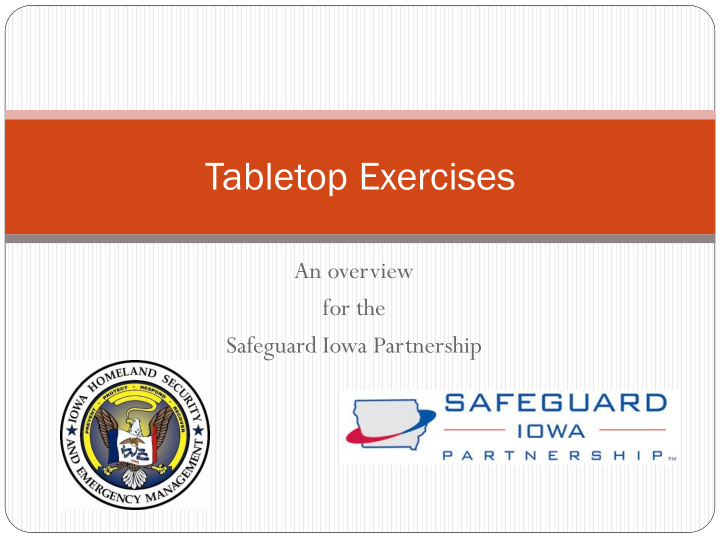



Tabletop Exercises An overview for the Safeguard Iowa Partnership
Using HSIN Connect Please turn on your computer speakers to listen to the audio. This webinar is being recorded and a copy will be available on the Safeguard Iowa Partnership website for future viewing. At the end of the presentation the presenters will take questions. To submit a question use the Chat feature available on the left-hand side of your screen.
Brought to you by Safeguard Iowa Partnership in collaboration with our partner Iowa Homeland Security and Emergency Management.
Welcome and Introductions John Halbrook – Steve Warren – Exercise Planner HSEMD Exercise Planner HSEMD
Webinar Objectives Exercise philosophies and methodologies Describe the purposes and characteristics of a tabletop exercise. Describe the steps in facilitating a tabletop exercise. Review documents that can be used to support tabletop exercises (TTX) Moving forward from tabletop exercises
HSEEP HSEEP = Homeland Security Exercise Evaluation Program A nationally recognized methodology Adopted from federal, military and private sector exercise programs Established based upon best practices Common structure and terminology
Progressive Exercising Broad commitment: Multiple groups involved in planning, preparation, and execution. Careful planning: Each exercise carefully planned to achieve identified goals. Increasing complexity: Increasingly complex exercises build on each other until mastery is achieved.
Goals and Objectives We start with goals not Scenarios Goals will tell us the scenarios that fit our exercise If we start with the scenario we don’t always fit in all of our goals Example Identify which staff will set up an alternate work site during a Continuity of Operations Plan (COOP) event. Identify IT connectivity gaps in our emergency plan Evaluate the plans to mobilize the coordination center during an emergency.
The Tabletop Exercise Discussion Based
Tabletop Characteristics Purpose: Solve problems as a group. Format: Discussion guided by facilitator. No simulators. No elaborate facilities or communications. Audience Policy and executive level (Think decision makers) Evaluation: Observers may be present. Success measured by participant feedback, impact on policies, plans, procedures.
Designing a Tabletop Exercise Use 8-step process, job aids Needs Assessment Scope Purpose statement Objectives Narrative Major/Minor Events Expected Actions Messages
Applying the Design Steps Narrative: Shorter Printed (or in person, TV , radio) As a whole or in parts Discussion items Events: Closely related to the objectives Only a few are required Used as basis for problem statements
Applying the Design Steps Expected Actions: List serves as a basis for developing problem statements and messages. ―Actions‖ may be discussion that leads to change. Messages: A few may suffice. May relate to major or detailed events.
Facilities and Materials Classroom, Office space, conference facility, or Operations centers Materials: Plans, policies Maps Other references
Problem Statements, Messages Present verbal problem statements to: Group. Individuals, then open discussion to group. Deliver prescripted messages to individuals, who coordinate with others and respond. Take time to resolve tough problems.
Facilitating the Exercise Strategies for setting the stage: Welcome Briefing Narrative Ice breaker
Facilitating the Exercise Strategies for involving everyone: Organize messages Encourage Elicit — do not provide — solutions Eye contact Positive Reinforcement
Supporting Documents Situation Manuals Provides players all of the background information they need for the exercise Lists Scope, Purpose Statement and Objectives Defines roles and responsibilities for all participants Establishes the exercise ―Rules‖ Exercise Agenda May Provide players with the questions and references Should be distributed before the exercise
Evaluating the Exercise Scribes can take notes during discussions (if appropriate) Participant feedback forms Capture players concerns and observations Help make future activities more appropriate for audience Outside evaluators and experts can identify improvements or issues.
Tools and Templates HSEEP/Exercise Design class January 24-27 2012 October 16-19 th 2012 Iowa Homeland Security Emergency Management http://www.iowahomelandsecurity.org/ HSEEP website https://hseep.dhs.gov Exercise document templates https://hseep.dhs.gov/hseep_Vols
Thank You John Halbrook Steve Warren John.Halbrook@iowa.gov Steve.Warren@iowa.gov (515) 725-3280 (515) 725-3201
Questions? To submit a question or comment use the Chat feature located on the left-hand side of your screen.
Recommend
More recommend